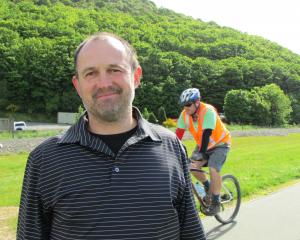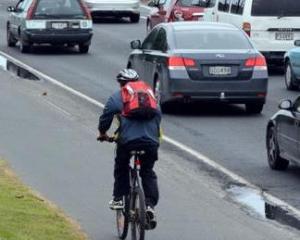A proposal to install separated cycle lanes on parts of State Highway 1 through central Dunedin has attracted more than 1000 submissions in the first four days of consultation.
New Zealand Transport Agency (NZTA) project team leader Simon Underwood said no other project he had been involved in for the agency had received 1000 submissions.
''And this has only been open for a few days. There's been an incredible amount of interest.''
Mr Underwood said feedback on the project had already shown a level of concern about having to share road space with other users.
''There's been quite a few comments along the lines of cyclists shouldn't be here, they should be somewhere else. It's almost a bit nimby, they say 'put them on the footpath, and then it's not my problem any more'. But then it becomes the pedestrian's problem.''
Others suggested having cyclists use alternate roads, but there was not somewhere else, ''or somewhere else any better''.
The NZTA started consulting last Friday on two options - both separated cycle lanes on the right-hand side of the roads, between the footpath and the traffic lanes - to improve the safety of cyclists using the one-way streets through Dunedin.
The working party that came up with the options had considered moving cyclists to the footpath, but decided against it for several reasons, Mr Underwood said.
The first reason was the likely conflict with pedestrians, which the agency had already experienced on the less busy shared paths around the city, where pedestrians complain cyclists should use bells, and cyclists complain pedestrians should not walk dogs on the path.
The footpaths along the one-way sections of SH1 were probably not as quiet as people thought, especially around the university area, and the NZTA was looking for somewhere where there could be a continuous cycle lane, he said.
There were also issues with vehicles exiting properties straight on to a shared lane, which was difficult enough to manage with pedestrians.
''We can't have cyclists cycling along the side of buildings and fences where people are coming out of access ways. It would be a disaster.''
Cyclists needed to be dealt with differently at traffic signals, too, because they needed longer to cross.
''So it's already getting extremely difficult.''
Added to that, the footpath was not very wide, when parking meters and lighting was taken into account, and making it wider would involve moving those things and kerbing and drainage - ''a massive exercise'' that would cost ''huge dollars''.
Removing pedestrians from the right-hand side footpath altogether was not an option, because there were properties and houses along the road that people needed to be able to walk to, and the NZTA wanted people to use traffic lights to cross the roads, rather than cross mid-block, as they would if there was no footpath.
''I just wouldn't want to go there at all.''
The agency was suggesting taking parking out, but in all other respects was trying not to compromise the use of the highway roads for other road users.
''To take a footpath out would be adversely compromising another road user's use of the road.''
There was no room for a cycle lane between the footpath and roadside parking. It would leave no shoulder between parked cars and travelling cars and people would be opening their doors directly into the traffic lane, and doing parking manoeuvres in the traffic lane.
A lot of thought had gone into the options that had been presented, and those that were not had been ruled out for good reasons, he said.








